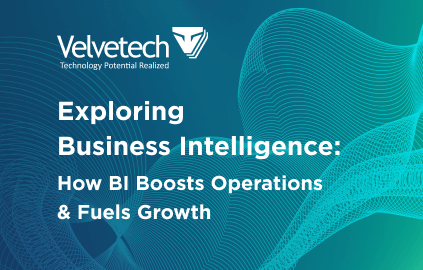In a world where data is the new currency, businesses find themselves navigating a digital wilderness filled with enormous amounts of information. It’s like a thousand-piece puzzle with no picture in the box. To solve this puzzle, you will need appropriate tools and methods. Here is where business intelligence comes into play.
Needless to say, the basis of any successful BI initiative lies in a robust and well-structured business intelligence architecture. Basically, it is the underlying framework that enables companies to collect, process, store, and analyze data to get valuable insights. At its core, this method aims to ensure that data is accessible, reliable, and optimized for further reporting and analysis.
Let’s delve deeper into the essence of BI architecture to discover its components and understand what benefits you can reap by implementing the robust one. Particularly, we will focus on the following:
BI for Business
Find out the secrets of how business intelligence boosts operations and what BI tools and practices drive data analysis.
Components of a Business Intelligence Architecture
Typically, a BI architecture contains a range of components that work together to help businesses gain valuable insights from data. Each component has its significant role. Let’s have a look at the critical elements of the BI ecosystem and see how they work.
Data Sources
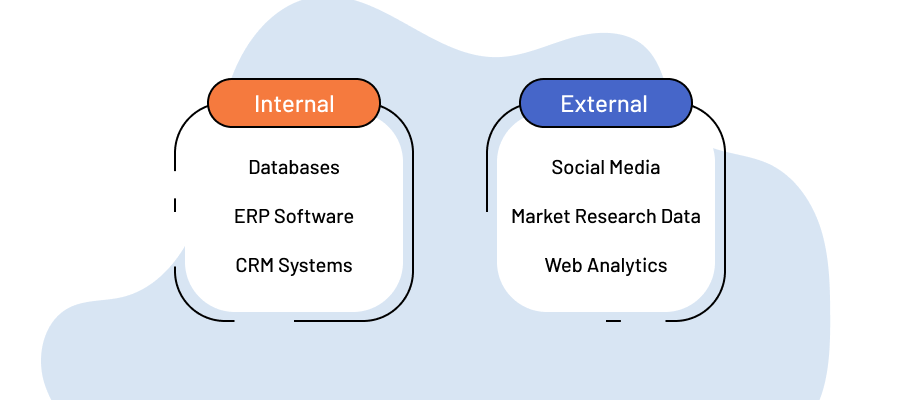
Data sources are the cornerstone of business intelligence architecture. Basically, there are both internal sources, such as databases, ERP, and CRM systems, and external — social media, market research, and web analytics sources. They provide the raw data needed for analysis and decision-making.
When identifying sources, considerations like relevancy, freshness, and quality come into place. Here it is also important to understand what type of data you need to get from sources — structured or unstructured. Typically, it depends on your business’ final goal. In some cases, you may opt for structured information only or incorporate it alongside semi-structured and unstructured types.
Data Integration Tools
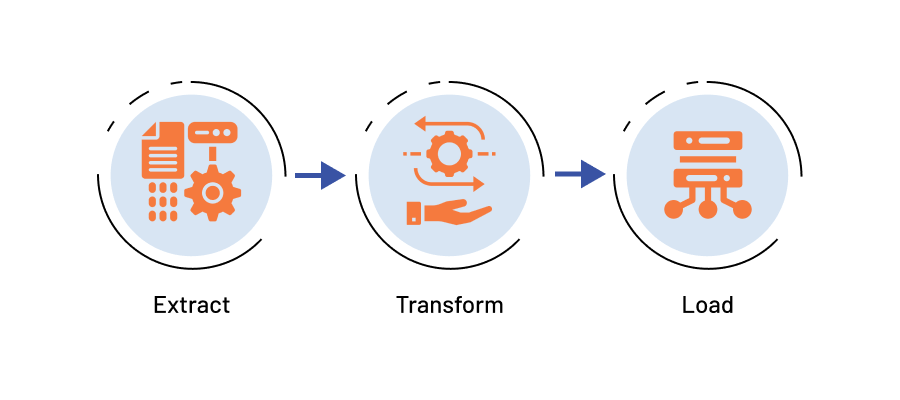
With so many sources, it is important to integrate information accurately into the BI ecosystem. Here are some ETL (extract, transform, load) tools that play a significant role in this process:
- Azure Data Factory
- Google Cloud Dataflow
- AWS Glue
- Informatica Mapping Designer
- Talend
Generally, ETL tools clean, combine, and integrate data. These steps guarantee that information is properly formatted, standardized, and connected for effective analysis and reporting.
Overall, ETL tools help companies gather data from different sources and put it all in one central storage. Thus empowering businesses to simply access, analyze, and gain important insights from data.
Data Storage
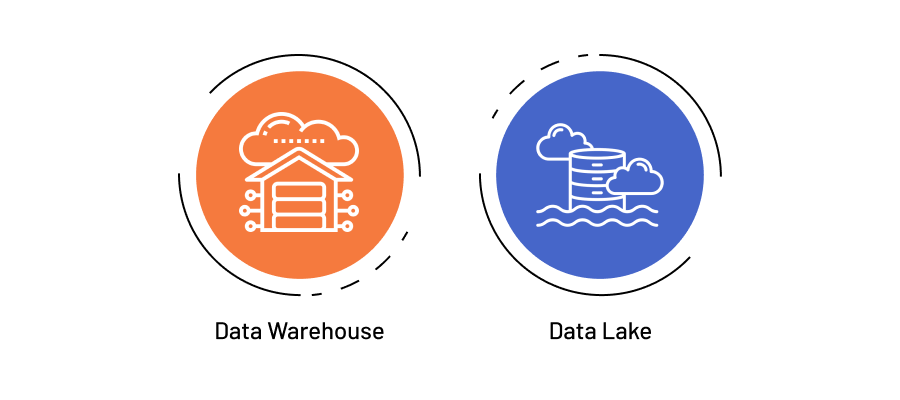
When it comes to storage, there are several data repositories, and among them are data lakes and data warehouses. The first one contains unprocessed and raw data. The second one, on the other hand, stores structured and semi-structured data in organized schemas that are best for analysis and querying.
You can also choose a hybrid approach and employ both warehousing and lakes in your BI architecture to benefit from a variety of sources.
Discover the key Differences Between Data Warehouses and Data Lakes
Whatever storage you choose, you will likely deal with a vast amount of information. Here, it is important to have robust data modeling to create logical representations. Basically, modeling structures data for optimized BI queries, employing techniques like star and snowflake schemas.
Oftentimes, the role of modeling is underestimated. In fact, it should be built right from the beginning and employed in a business intelligence architecture. Otherwise, you risk dealing with poor data management.
On top of that, the model itself should be as simple and straightforward as possible. It is also worth keeping it adaptable to changing business needs and technologies.
Learn about top Data Modeling Techniques for Advanced Data Management
Data Processing

Data processing is another essential component of the business intelligence framework.
To transform your information into valuable insights, efficient processing requires specific tools. And one of them is data aggregation. It helps group records by the time period, region, product category, or other relevant dimensions.
At its core, aggregation aims to simplify complex datasets, making them more accessible and meaningful for BI users. You can go even further and implement machine learning in your data processing. It can help automate operations like cleansing, transformation, and data preparation.
On top of that, you can include predictive analytics in processing to forecast outcomes. By having correct historical records, you can have a clear picture of the market’s future trends, stay relevant with changes, and remain competitive.
Data Access Layer

The Data Access Layer (DAL) is a fundamental component of the BI architecture, serving as the bridge between raw data sources and the business logic layer. Its primary responsibility is to retrieve, store, and manage data from databases, cloud storage, APIs, or other data repositories.
By abstracting and encapsulating the underlying data operations, the DAL ensures that data retrieval and storage mechanisms are consistent, efficient, and secure. This abstraction also allows the higher layers, like the business logic layer, to interact with data without needing to know the specifics of the underlying data sources or storage mechanisms.
As a result, changes in data sources or storage strategies can be implemented in the DAL without disrupting the functionality of the application layers above it.
Business Logic Layer
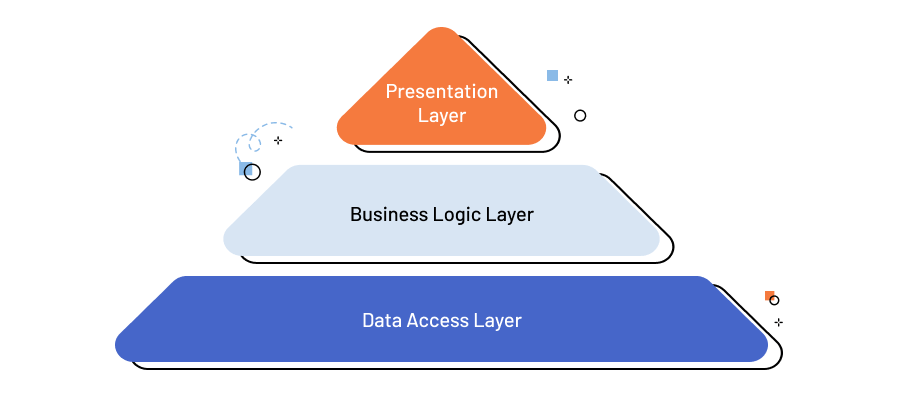
Another crucial component of BI architecture is the Business Logic Layer (BLL). Positioned above the data access layer and below the presentation layer, the BLL plays a pivotal role in applying business rules to data. While it does handle the modification of information, its primary function is not just processing. Instead, it filters user input, enforces business logic, and prepares data either for storage or for presentation to the end user.
As a quick side note, BLL is not a random database repository. Instead, it encompasses specific databases within the BI ecosystem that are logically interconnected. To help you gain a better understanding of the BLL process, let’s take a look at an example.
Consider that you need to collect sales information from various sources, including physical stores and online platforms. The BLL plays a critical role by aggregating them. It calculates important metrics like monthly sales revenue, identifying top-selling products, and applying business rules to assess inventory turnover rates.
According to your request, BLL provides relevant information, empowering you to assess the performance of your stores. After, the presentation layer enters the game, making this information visually appealing and digestible for you. Let’s talk about it in the next chapter.
Presentation Layer

As a brief grasp of the definition, the presentation layer serves as a user-friendly interface, enabling users to engage with the application effortlessly. This layer plays a crucial role in enhancing the overall UI/UX design of the software. To get to the point, this component of business intelligence architecture uses specialized reporting and analytics tools like Power BI, Tableau, or QlikView to extract insights from structured data.
The pros of the presentation layer extend further. It can help your business craft unified templates, ensuring a consistent design across all reports and dashboards. As a result, your visuals will look professional and eye-catching.
Furthermore, with a well-designed BI architecture, you can automate this process and prepare reports within a couple of minutes.
Discover key steps to Create a User-Centered Design
Business Intelligence Architecture Diagram
Though building a robust BI architecture can seem scary and complex, don’t worry — you don’t need to understand every detail when you have a team of experts by your side. It will help organize all the above-mentioned components and make them work smoothly. So, as a result, you will get a cutting-edge BI ecosystem.
To provide you with a broad understanding of how the elements of architecture interact with each other and stay on the same page with your team, we suggest having a look at a diagram.
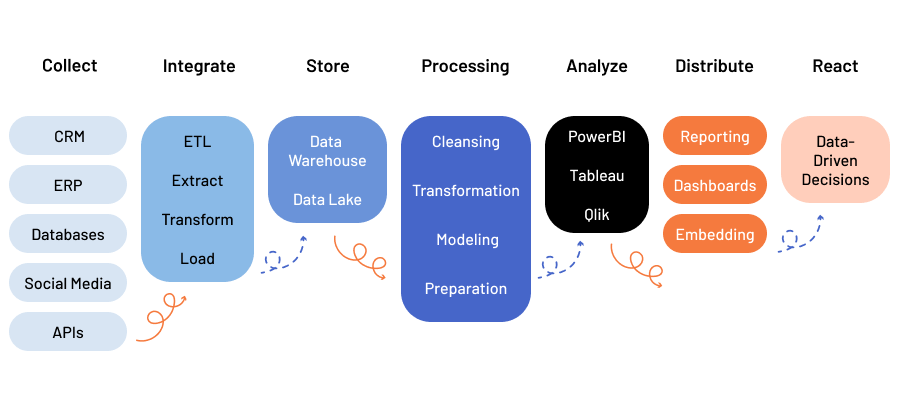
Fundamental Principles for Building an Effective Business Intelligence Architecture
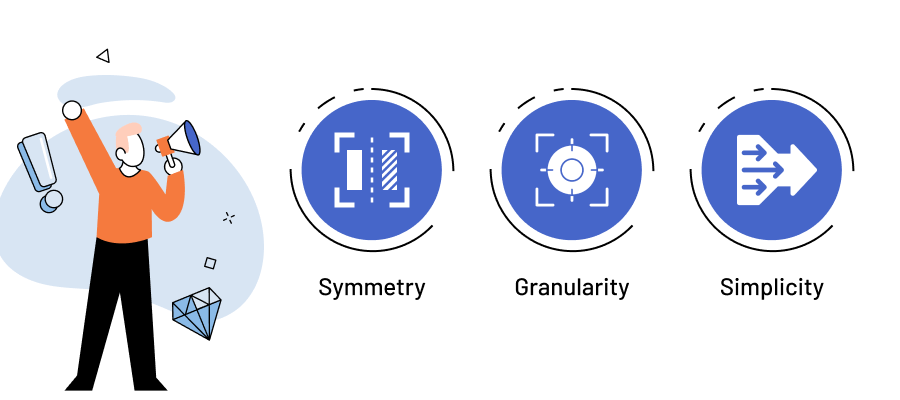
If you decide to deploy a BI ecosystem, there are some core principles that are worth following. Let’s discuss them in more detail.
1. Symmetry
Symmetry kicks in when we need to make reports easy to understand and compare. It can be applied to data structures, particularly when working with multi-dimensional models such as OLAP (online analytical processing) cubes. Data model symmetry ensures that similar types of information are structured and displayed consistently.
2. Granularity
Too few details may not provide enough insights, and too many can lead to confusion. So, it is important to use only the sources you need. Proper granularity guarantees that BI users can analyze data effectively without being overwhelmed with unnecessary details.
For example, you may need website traffic analytics to track visitor behavior and improve your site’s performance and sales. If you collect only total page views, that might not be enough. You can miss important information such as where users come from, on what pages they spend the most time, which products generate the most interest, and the like.
Whereas, when you collect more granular data, such as page-level views, click-through rates on product listings, and similar metrics, you can gain a deeper understanding of user interactions.
3. Simplicity
The architecture of your business intelligence system should always be designed with end users in mind. If the interface of your BI solution shows high complexity for users, it’s likely that your employees won’t be able to leverage data effectively. And really, it’s not a secret that one of the primary goals of BI is to make complex data analysis accessible to non-technical employees.
Therefore, it’s crucial to prioritize simplicity and employ BI tools like PowerBI, Qlik, or Oracle Analytics Cloud that will assist your employees along the way.
Discover how a solid Data Analysis can Shape your Business
Top Advantages of a BI Architecture to Consider
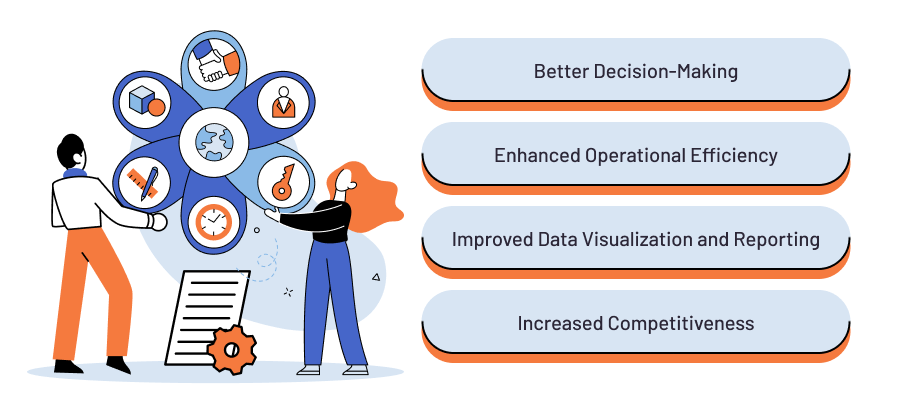
Continuing our journey along the business intelligence architecture, it’s time to talk about the benefits. While it’s probably already clear that a robust architecture has many advantages to offer, let’s skim through the most important pros that are worth considering.
1. Better Decision-Making
With a well-implemented business intelligence architecture in place, you can make timely and accurate decisions, which is important in order to gain a competitive advantage. Such architecture streamlines the process of accessing, analyzing, and storing data systematically, ensuring the detection of outdated or incorrect information.
On top of that, a strong architecture centralizes data and enables everyone in the company to have a single source of truth. That definitely increases the trustworthiness of your insights.
Keep reading to explore Key Data Analysis Approaches for Decision-Makers
2. Enhanced Operational Efficiency
Another benefit of a well-planned BI architecture is its ability to enhance business operations. By automating activities like data integration, cleansing, or transformation, it is possible to minimize human errors. That’s why today, many companies use automation to streamline their operations, reduce costs, and make more informed decisions.
With the rise of artificial intelligence and machine learning, automation has undergone a significant transformation. In the future, AI and ML will probably automate as many business processes as possible. Moreover, to get to the point, companies probably will utilize hyperautomation to optimize processes of almost any complexity.
According to Gartner, the hyperautomation software market is projected to approach USD 1.04 trillion in 2026, reflecting a compound annual growth rate of 11.9%. Just imagine what a picture we will have for the upcoming decade. Possibly, by that time almost all business operations will be fully automated.
Discover how to Transform Your Business Operations with Hyperautomation
Automation is just one of the top ways to enhance operational efficiency. If you want to propel your business forward, then keep an eye on the cutting-edge technologies that a BI ecosystem has to offer.
3. Improved Data Visualization and Reporting
Regardless of the important insights you gain, if they’re presented in a complex way, people may not find them compelling or easy to understand. With a well-crafted and strong BI architecture, there is no need to worry about things like that.
The BI ecosystem contains tools for crafting data visualizations and reports that are not only logically structured but also visually appealing. So, for example, if you need to prepare a report or presentation for stakeholders or your partners, you can utilize dynamic dashboards, charts, and graphs. They will help you ensure that the information is easily digestible, interactive, and engaging.
4. Increased Competitiveness
Knowing customer preferences, market demand, and trends helps obtain a competitive edge. You can access all of these insights through your business intelligence architecture. Moreover, if your BI environment enables real-time data access, you can swiftly respond to changing conditions.
Just remember that not all architectures provide real-time capabilities. Hence, build your architecture aligned with your business goals, otherwise, you will need to change it or build a new one from scratch.
Best Practices for Deploying and Harnessing a BI Architecture
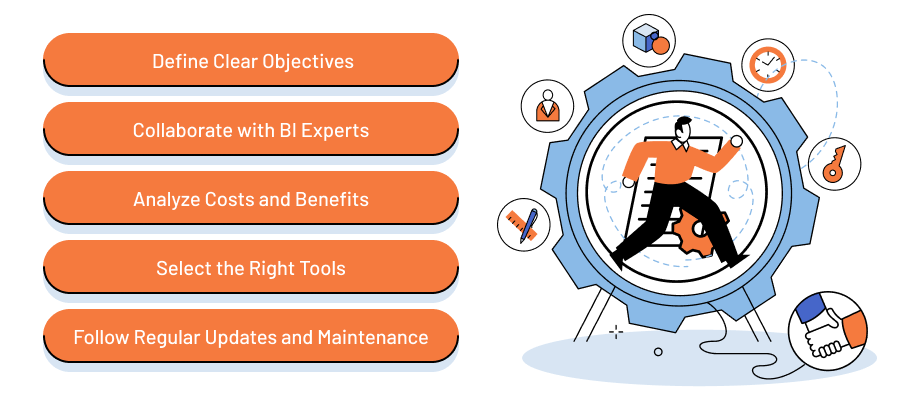
We have discussed many important aspects of business intelligence architecture so far. Now you have a clear idea of key components and best principles to help you build a cutting-edge BI ecosystem. You also know the core benefits it can bring to your business. But before wrapping up, let’s have a quick view of the key steps required to implement a robust BI system.
Define Clear Objectives. To create a result-oriented BI system, you should first define your organization’s goals. Only after that can you choose the best architecture that aligns with the company’s needs.
Collaborate with BI Experts. In order to create an appropriate BI ecosystem, it is worth working with BI experts at an early stage. They can help you build a flexible architecture that can be adapted to changes in technology, data sources, and business requirements. Otherwise, you risk changing it in the future, which will cost you both money and precious time.
Analyze Costs and Benefits. Compare BI ecosystem implementation costs with the potential benefits it can offer. If you see a promising future, then your investment is well worth it.
Select the Right Tools. There are many BI tools available on the market. Ideally, you should choose those that align best with your company needs and budget. Additionally, it is worth considering factors like scalability, user-friendliness, and integration capabilities during the tool selection.
Follow Regular Updates and Maintenance. A BI architecture, like any other IT system, requires regular updates and maintenance. So, it is vital to make sure your architecture is accurate and current with new versions and security patches.
BI for Business
Find out the secrets of how business intelligence boosts operations and what BI tools and practices drive data analysis.
Transform Your Business Operations with a Cutting-Edge BI Architecture
Having explored the power of a well-crafted business intelligence solution, you may be driven to embark on this path. However, you may face many challenges on your journey to harness the transformative potential of a BI architecture.
If you do not have a skilled team to help you, no worries — Velvetech will assist you along the way. With our proven expertise in this field, we will build the right architecture for your BI software to ensure its growth and innovation.
Reach out to us today.
